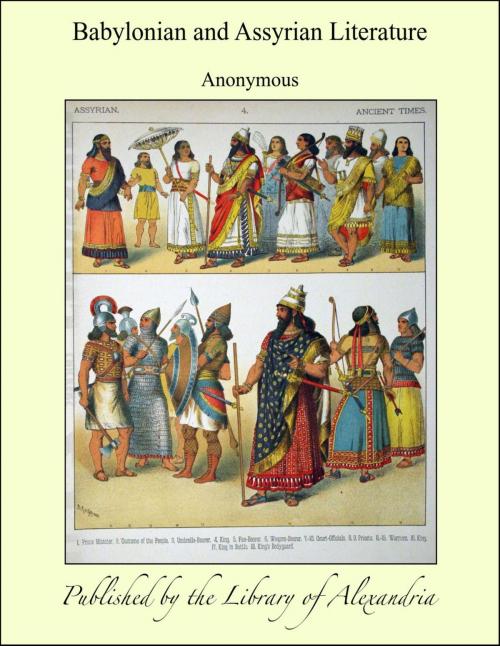Babylonian and Assyrian Literature
Nonfiction, Religion & Spirituality, New Age, History, Fiction & Literature| Author: | Anonymous | ISBN: | 9781613107447 |
| Publisher: | Library of Alexandria | Publication: | March 8, 2015 |
| Imprint: | Language: | English |
| Author: | Anonymous |
| ISBN: | 9781613107447 |
| Publisher: | Library of Alexandria |
| Publication: | March 8, 2015 |
| Imprint: | |
| Language: | English |
The great nation which dwelt in the seventh century before our era on the banks of Tigris and Euphrates flourished in literature as well as in the plastic arts, and had an alphabet of its own. The Assyrians sometimes wrote with a sharp reed, for a pen, upon skins, wooden tablets, or papyrus brought from Egypt. In this case they used cursive letters of a Phoenician character. But when they wished to preserve their written documents, they employed clay tablets, and a stylus whose bevelled point made an impression like a narrow elongated wedge, or arrow-head. By a combination of these wedges, letters and words were formed by the skilled and practised scribe, who would thus rapidly turn off a vast amount of “copy.” All works of history, poetry, and law were thus written in the cuneiform or old Chaldean characters, and on a substance which could withstand the ravages of time, fire, or water. Hence we have authentic monuments of Assyrian literature in their original form, unglossed, unaltered, and ungarbled, and in this respect Chaldean records are actually superior to those of the Greeks, the Hebrews, or the Romans. The literature of the Chaldeans is very varied in its forms. The hymns to the gods form an important department, and were doubtless employed in public worship. They are by no means lacking in sublimity of expression, and while quite unmetrical they are proportioned and emphasized, like Hebrew poetry, by means of parallelism. In other respects they resemble the productions of Jewish psalmists, and yet they date as far back as the third millennium before Christ.
The great nation which dwelt in the seventh century before our era on the banks of Tigris and Euphrates flourished in literature as well as in the plastic arts, and had an alphabet of its own. The Assyrians sometimes wrote with a sharp reed, for a pen, upon skins, wooden tablets, or papyrus brought from Egypt. In this case they used cursive letters of a Phoenician character. But when they wished to preserve their written documents, they employed clay tablets, and a stylus whose bevelled point made an impression like a narrow elongated wedge, or arrow-head. By a combination of these wedges, letters and words were formed by the skilled and practised scribe, who would thus rapidly turn off a vast amount of “copy.” All works of history, poetry, and law were thus written in the cuneiform or old Chaldean characters, and on a substance which could withstand the ravages of time, fire, or water. Hence we have authentic monuments of Assyrian literature in their original form, unglossed, unaltered, and ungarbled, and in this respect Chaldean records are actually superior to those of the Greeks, the Hebrews, or the Romans. The literature of the Chaldeans is very varied in its forms. The hymns to the gods form an important department, and were doubtless employed in public worship. They are by no means lacking in sublimity of expression, and while quite unmetrical they are proportioned and emphasized, like Hebrew poetry, by means of parallelism. In other respects they resemble the productions of Jewish psalmists, and yet they date as far back as the third millennium before Christ.















